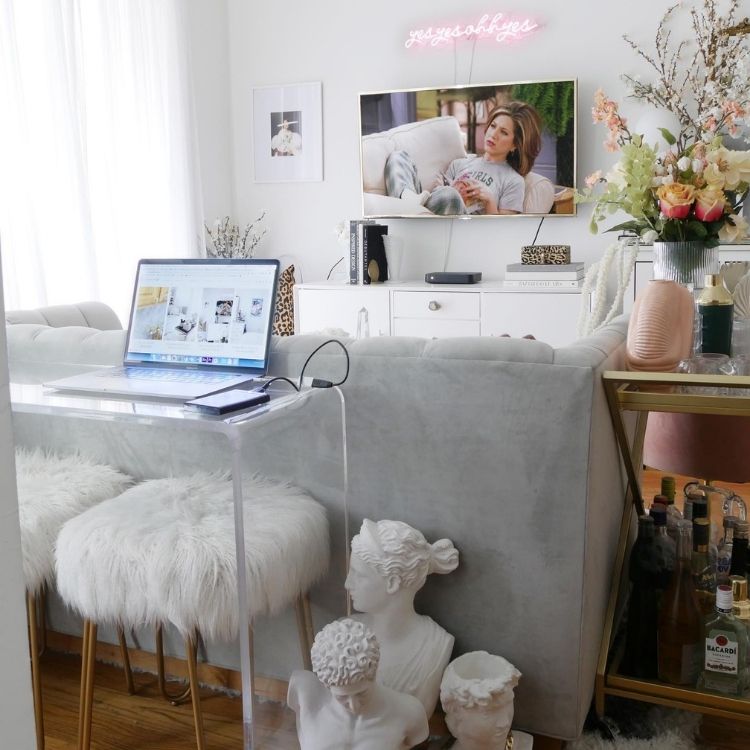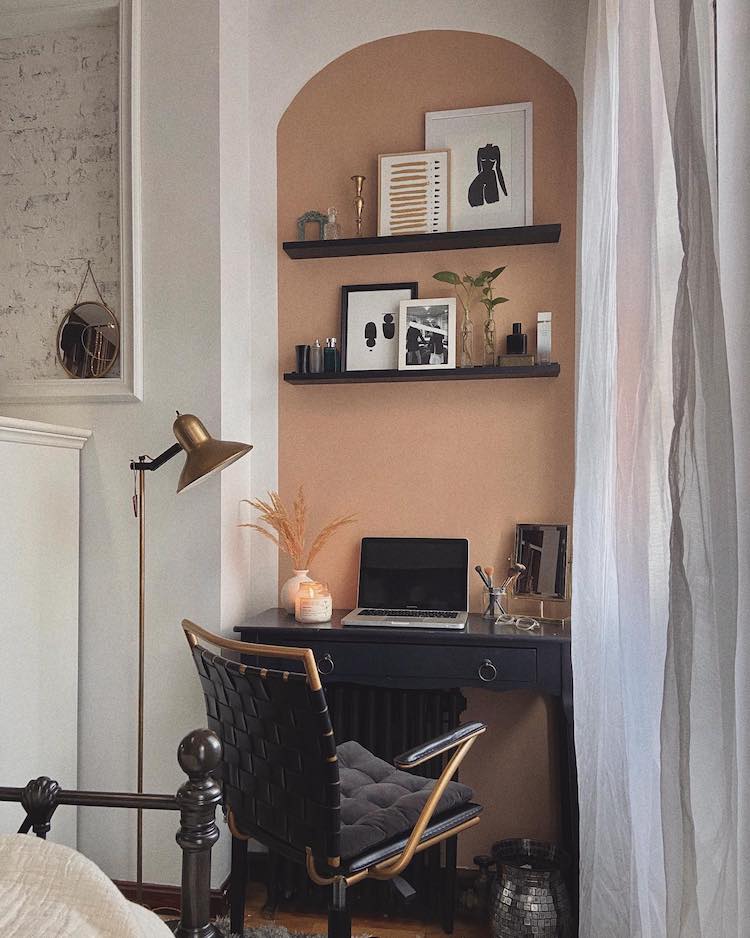
My husband and I both worked from home together long before the pandemic sent workers home with their laptops. Did I mention we live in a one-bedroom apartment?
Create a Designated—But Cute—Work Space
This part is going to sting a little. I know how tempting it is to move your laptop from your bed to your couch to your kitchen table, all to avoid adding office furniture to your living room. It’s not a cute look, but you deserve a real workspace to turn to every day. My solution to softening the blow was to avoid office-looking accessories. You can buy a beautiful desk and desk chair and finish it off with charming accessories that don’t look like they came from an office supply store. Splurging on a notebook you love to look at or a marble tray to collect pens and paper clips can change how you feel about your work space and can help it blend in when you have friends over for a dinner party.
The reason setting up a work space you love is so important is that it will motivate you to work at your desk more often. Is the bed comfortable? Yes. Is it the best place to get work done? More often than not, no. There are no rules in a home office (it’s your living room, after all!), so create a work space you love to look at and work in.

Source: @mycityapartment
Invest in the Right Supplies
Why did it take me and my husband years to invest in a pair of noise-canceling headphones? No idea. What I do know is that we won’t be going back. We didn’t even need to splurge on two pairs. Whichever one of us isn’t on a call will wear them while the other person takes their calls, and they really do block out enough noise so I’m not distracted by what’s going on in the background. Having a pair of headphones like this also signals to your live-in coworker that you aren’t available to talk.
This pair of headphones from Microsoft does wonders for us and costs half as much as other popular brands (we’re looking at you, Apple).
Set Boundaries
Do you have a roommate who likes to chat when they’re eating lunch and you’re not? Does your neighbor stop by to talk since they know you’re working from home? Does your very helpful mom want to drop off groceries again? When working from your living room, it’s super important to set boundaries. Make it clear to friends and family, whether you live with them or not, that just because you’re working from home doesn’t mean you’re available to chat.
It’s also important to remember that you don’t have to remain responsive at all times. You can put your phone in the other room or ignore a non-emergency text or call until you log off at the end of the day.
Communicate Clearly
To make sure we don’t slow each other down during the workday, my husband and I are super communicative regarding when we are available to connect with each other. In the morning, we go over our schedules for the day so we know when to expect the other person to be completely unavailable (like during a meeting). Then, throughout the day, we check in to see if now is a good time to go on a walk or to eat lunch together. If someone is getting chatty and the other person needs to focus, we just let each other know. You can’t get what you don’t ask for! If you live with a roommate, family member, or romantic partner, simply let them know what you need to feel good about your productivity levels.
The same thought process applies with coworkers who can distract you from a distance. It can be tempting to be responsive at all times when working from home to prove you are in fact working, but sometimes, you need to carve out time to focus solely on the task at hand. Don’t be afraid to tell your manager or teammates you’re going to be heads down for two hours and won’t be responding to Slack or emails during that time.

Source: Samson Katt | Pexels
Plan for Breaks
When you work from home, it’s so easy to feel guilty about taking breaks. When I was in an office, I thought nothing of taking a 15-minute break to chat with a coworker. When you’re in an actual office and interacting with coworkers, a break feels more like a normal part of your workday. At home, it can feel like you’re slacking off. And to be fair, it’s really easy to let a quick coffee break turn into a much longer break than intended when you’re at home and there is laundry to do or a cute pup to play with.
Scheduling breaks can help you get over these hangups. Each day when I sit down at my desk, I look at what I need to accomplish that day and when I have meetings that day. Then, I use time blocking to plan out when I will work and when I will take a break. Do I schedule the break down to the minute? No. But I will say that between 9 a.m. and 12 p.m., I am going to clear my inbox, finish writing a blog post, and go on a walk. That way, taking breaks feels like a regularly scheduled part of my day, I know when they need to be completed, and I get to rest, which helps me be more productive throughout the day.







